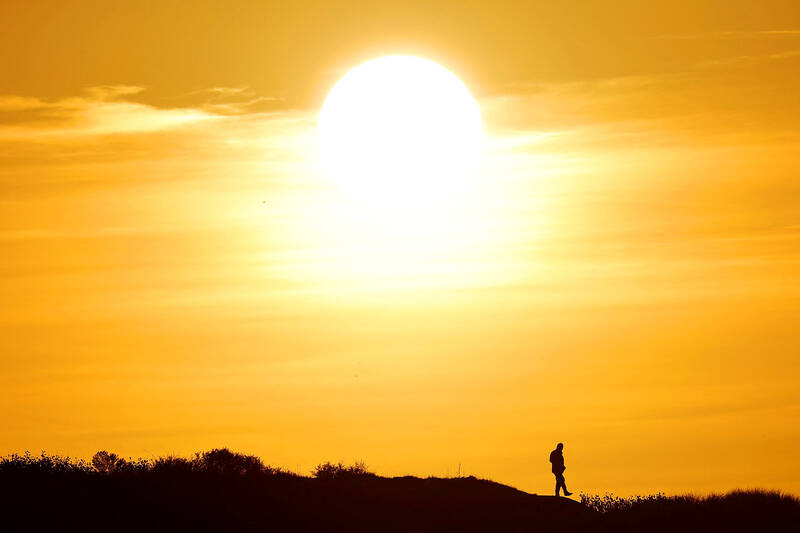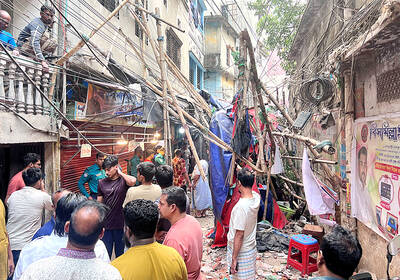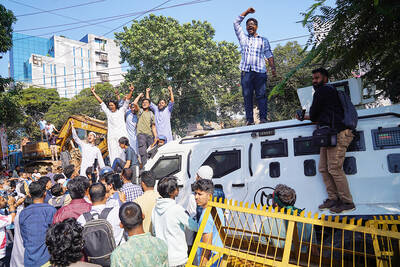Europe is set for a mild November, easing pressure on natural-gas storage as the region’s energy crunch restricts supplies ahead of winter.
Long-range outlooks from forecasters Maxar Technologies and Marex show no cold spells for the month — a relief for households worried about the cost of heating and for governments keen to preserve gas stocks following a slump in Russian supply.
“In terms of energy demand, the warm start to November would be a welcome sign given the current state of global energy,” said Matthew Dross, a meteorologist at Maxar. “Still, occasional bouts of cold air cannot be ruled out for November and the winter 2022-2023 season as a whole.”

Photo: Reuters
European gas prices have dropped significantly since peaking in August, but are still about 80 percent above year-ago levels. Market spikes have driven up costs for consumers and industry, with many bracing for eyewatering winter bills.
“Strong above-normal” temperatures are expected early this month, while mild weather will continue through the month, Dross said.
Other forecasters have suggested a possible return to average temperatures in the second half of this month.
Autumn in Europe has already been unseasonably warm, with last month registering the lowest number of “heating-degree days” since 2000, Dross said.
That has helped keep gas in storage facilities, which are now about 95 percent full across the continent, with Germany’s sites above target at almost 99 percent.
Germany’s national forecaster Deutscher Wetterdienst said the country’s current warm weather is set to continue, while France’s weather service also sees higher-than-usual temperatures persisting.
In the UK, the chances of a colder-than-normal winter are actually increasing, although the most likely scenario remains an average winter through next month, Britain’s Met Office said.
Lower-than-expected gas demand and declining prices — coupled with limited capacity to accommodate incoming cargoes of liquefied natural gas (LNG) — have already triggered greater use of floating storage. Traders globally are keeping their LNG shipments on vessels for longer — with record volumes at sea last month — in anticipation of higher prices later in the season.
“LNG carriers with an estimated worth of about US$2 billion are currently queuing to unload their cargo,” said Alexandre Fierro, a senior meteorologist and research analyst at Marex in London.
A warm November would be far from solving Europe’s energy problems, but a delayed start to the heating season would at least give policymakers some breathing room.
Moreover, if the region is spared a deep freeze this winter — as predicted by scientists at the Copernicus Climate Change Service — consumers might get welcome respite from the worst cost-of-living crisis in decades.

DISASTER: The Bangladesh Meteorological Department recorded a magnitude 5.7 and tremors reached as far as Kolkata, India, more than 300km away from the epicenter A powerful earthquake struck Bangladesh yesterday outside the crowded capital, Dhaka, killing at least five people and injuring about a hundred, the government said. The magnitude 5.5 quake struck at 10:38am near Narsingdi, Bangladesh, about 33km from Dhaka, the US Geological Survey (USGS) said. The earthquake sparked fear and chaos with many in the Muslim-majority nation of 170 million people at home on their day off. AFP reporters in Dhaka said they saw people weeping in the streets while others appeared shocked. Bangladesh Interim Leader Muhammad Yunus expressed his “deep shock and sorrow over the news of casualties in various districts.” At least five people,

LEFT AND RIGHT: Battling anti-incumbent, anticommunist sentiment, Jeanette Jara had a precarious lead over far-right Jose Antonio Kast as they look to the Dec. 14 run Leftist candidate Jeannette Jara and far-right leader Jose Antonio Kast are to go head-to-head in Chile’s presidential runoff after topping Sunday’s first round of voting in an election dominated by fears of violent crime. With 99 percent of the results counted, Jara, a 51-year-old communist running on behalf of an eight-party coalition, won 26.85 percent, compared with 23.93 percent for Kast, the Servel electoral service said. The election was dominated by deep concern over a surge in murders, kidnappings and extortion widely blamed on foreign crime gangs. Kast, 59, has vowed to build walls, fences and trenches along Chile’s border with Bolivia to

DEATH SENTENCE: The ousted leader said she was willing to attend a fresh trial outside Bangladesh where the ruling would not be a ‘foregone conclusion’ Bangladesh’s fugitive former prime minister Sheikh Hasina yesterday called the guilty verdict and death sentence in her crimes against humanity trial “biased and politically motivated.” Hasina, 78, defied court orders that she return from India to attend her trial about whether she ordered a deadly crackdown against the student-led uprising that ousted her. She was found guilty and sentenced to death earlier yesterday. “The verdicts announced against me have been made by a rigged tribunal established and presided over by an unelected government with no democratic mandate,” Hasina said in a statement issued from hiding in India. “They are biased and politically motivated,” she

It is one of the world’s most famous unsolved codes whose answer could sell for a fortune — but two US friends say they have already found the secret hidden by Kryptos. The S-shaped copper sculpture has baffled cryptography enthusiasts since its 1990 installation on the grounds of the CIA headquarters in Virginia, with three of its four messages deciphered so far. Yet K4, the final passage, has kept codebreakers scratching their heads. Sculptor Jim Sanborn, 80, has been so overwhelmed by guesses that he started charging US$50 for each response. Sanborn in August announced he would auction the 97-character solution to K4